Wes Anderson, Guillermo del Toro and More Directors on Best 2022 Films
- Oops!Something went wrong.Please try again later.
- Oops!Something went wrong.Please try again later.
- Oops!Something went wrong.Please try again later.
- Oops!Something went wrong.Please try again later.
- Oops!Something went wrong.Please try again later.
- Oops!Something went wrong.Please try again later.
- Oops!Something went wrong.Please try again later.
- Oops!Something went wrong.Please try again later.
- Oops!Something went wrong.Please try again later.
- Oops!Something went wrong.Please try again later.
- Oops!Something went wrong.Please try again later.


This year, society almost got back to normal, with some caveats, and we all went back to film festivals and theaters, thankful for the myriad features from some of the best filmmakers around. In the following 19 essays, directors offer praise and insight into their favorite films — the movies that moved them the most or ones they found just plain astonishing — of 2022.
More from Variety
Jacob Elordi to Play Frankenstein's Monster in Guillermo del Toro's Netflix Adaptation
These Coffee Table Books Make the Perfect Gift for the Pop-Culture Lover in Your Life
Guillermo del Toro found Baz Luhrmann’s “Elvis” fascinating. “It was like a concert — it was experiential, peppered with details and perfectly observed mannerisms and hidden clues,” the “Pinocchio” director wrote. “Austin Butler and Baz showcase Elvis’ world shaking, transformative talent, his joy, his soul, his sadness — actor and director working in tandem to re-embrace and re-energize the power and danger that Elvis possessed.”
Wes Anderson, on the other hand, preferred Noah Baumbach’s “White Noise,” writing: “This is perhaps the most literary (and language-oriented) gigantic semi-science fiction blockbuster-scale movie ever made. College professors lecture. Academics debate. Grocery shoppers dance in the aisles. A giant toxic cloud is an existential threat; but first and foremost, it’s a metaphor. This movie is dazzling and mysterious and poetic and wildly entertaining.”
“Catherine Called Birdy” director Lena Dunham praised Maria Schrader’s “She Said,” writing that Schrader was “the perfect director to take on the horrors of Harvey Weinstein through the lens of the women who reported the bombshell New York Times story that marked the first chink in his armor.”
Read on for essays from the likes of Judd Apatow, Edgar Wright and Claire Denis.
Edward Berger’s ‘All Quiet on the Western Front’ by Kimberly Peirce
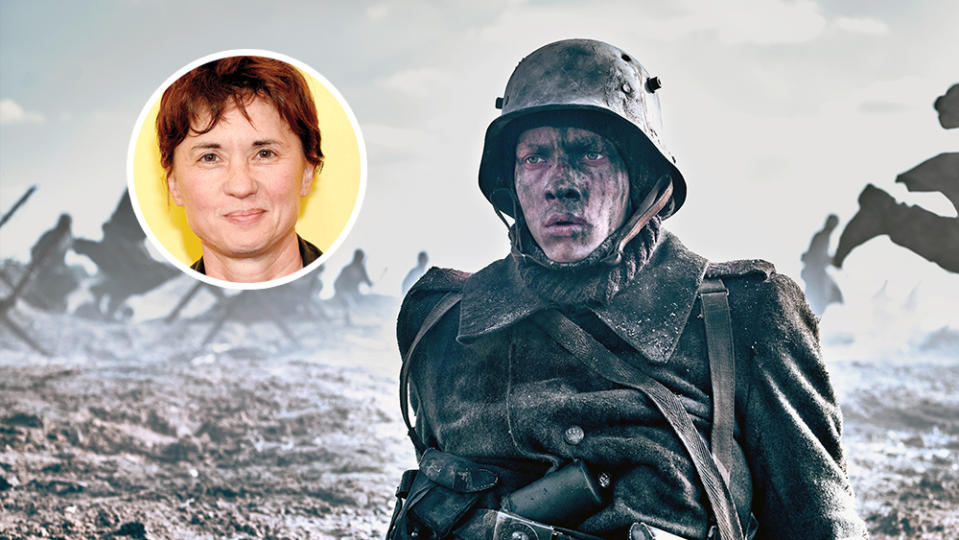
Depictions of war on the big screen are legion, but the most transcendent and indelible of them outlast the ages because they invite the viewer into a state of mind, not merely a numbing and unflinching cacophony of mortal terror.
Sumptuous. Mesmerizing. Moving. Three words encapsulate this brilliant film. Edward Berger has managed a courageous new adaptation of Erich Maria Remarque’s “All Quiet on the Western Front.” Courageous because Remarque’s work has already yielded a classic in Lewis Milestone’s 1930 version, which I had the great pleasure of seeing a decade ago at the Royal Albert Hall accompanied by the London Symphony Orchestra. So sublime was that rendering that I didn’t imagine I would ever want to see another version.
Yet Edward has managed to carve out his own definitive place with a take on the material that engages in bold and visceral ways. His vision of “The Great War” is a multi-sensory experience capturing the futility of men fighting over a few hundred meters of trenched terrain with strong visual storytelling techniques.
As just one example, the way the film tracks a fallen soldier’s uniform as it’s removed, laundered and re-enlisted for protagonist Paul Bäumer’s use, like so many other recyclable elements of war — this tiny cog in an overwhelming machinery — speaks with a volume that words simply never could.
Edward captures the humanity of his narrative by depicting the devastating transformation of our protagonist from a godly beautiful innocent eager-to-fight young soldier to a grunt following every order still unable to stop the cascading loss of his friends, to a man unleashed, echoing the monster he was set to slay.
Kimberly Peirce directed the award-winning and groundbreaking film “Boys Don’t Cry,” as well as TV series such as “Halt and Catch Fire,” “The L Word,” “Kidding” and “P-Valley.”
Alejandro González Iñárritu’s ‘Bardo, False Chronicle of a Handful of Truths’ by Lulu Wang
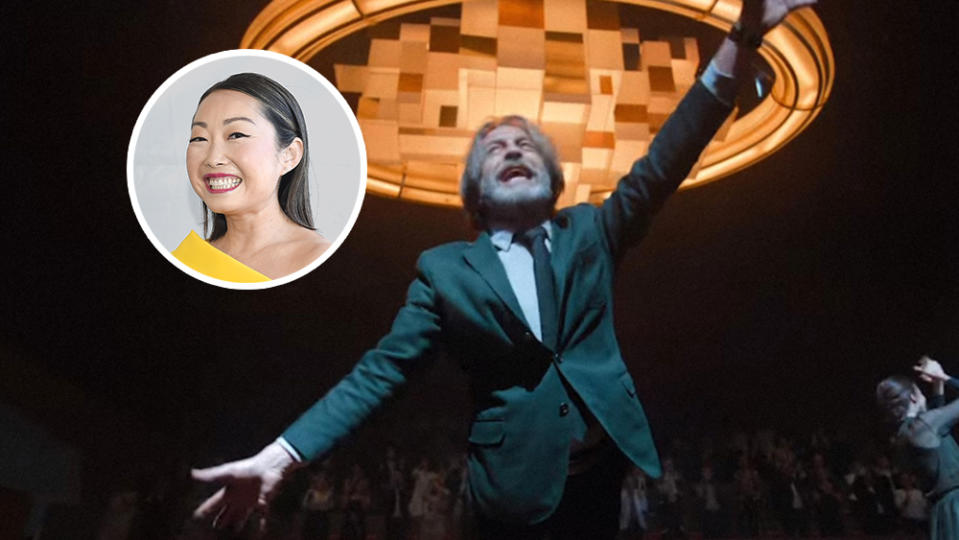
The best memoirs write towards vulnerability and examine truth, even at the risk of being exposed to ridicule. They are filled with reflection, redemption, remorse and renewal. While “Bardo, False Chronicle of a Handful of Truths” doesn’t claim to be an autobiography, Alejandro González Iñárritu puts all these qualities into this profound and shockingly vulnerable portrait of identity, heritage and a life reconsidered. It’s an exuberant film from a world-class artist who forges dreams (and nightmares) in lights and then dares to share it with the world.
This film is as much a love letter to Mexico as it is an existential poem for those living in diaspora. It encapsulates the fragmentation of living in-between different languages, different timelines, different realities. It is the inevitable disintegration that comes with integration. It is my mother interrupting me in the middle of a banal day — as I’m eating breakfast, or maybe as I’m about to walk into a meeting — to talk to me about the Cultural Revolution. Even as I tell her I’m busy, she continues on with absurd urgency in the style of Silverio’s vision of the Mexican American battle — narratively out of context, but with total emotional conviction.
Iñárritu fills his massive frame with a Borges-influenced, Fellini-esque cavalcade of the subconscious, but do not be fooled by the showy panache of “Bardo.” The grandiosity exists only to be undercut by the most sobering and soul-baring of moments — like an aging man returning to a childlike state to ask his dead father if he’s proud of him. That is the range and humility of this film. It is the largely desperate quest of one man to understand his place in life and in history, emerging on the other side with only one certainty — the value of family.
Lulu Wang directed and wrote the award-winning hit “The Farewell,” and currently has series “Expats,” with Nicole Kidman, in production.
Steven Spielberg’s ‘The Fabelmans’ by Judd Apatow
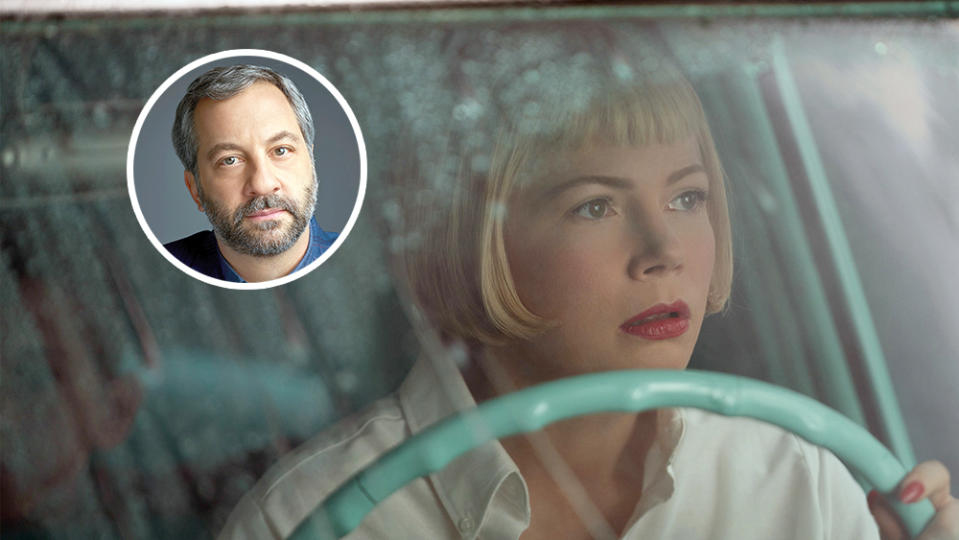
“The Fabelmans” feels like a movie that was made specifically for me. It is based on Steven Spielberg’s life and reveals how he became the greatest filmmaker of our time. As a child of divorce, I felt a deep connection to this story about a family struggling to hold together, how the traumas of a disintegrating marriage affect a young man and how it leads to him developing his creative muscles as a way to process his pain and interpret the world.
I was born in 1967 and my introduction to movies was “Jaws,” “Close Encounters of the Third Kind” and “E.T. The Extra-Terrestrial.” In many of Steven Spielberg’s films we saw damaged and divorced families still unhealed. The dinner table scenes in “E.T.” felt like my family. They were funny and hilarious, often sad. As a kid I loved “E.T.,” but even more I loved how that family communicated. It felt so true, so intimate.
Now, 40 years later, Steven Spielberg has made the type of film he never endeavored to create before, the story of his own childhood. It feels like such a gift, after receiving so many, for him to drop the metaphor and tell us the story that is closest to his heart. “The Fabelmans” is the heartbreaking, hilarious and moving film he did not have to make. Paul Dano, Michelle Williams, Seth Rogen and Gabriel LaBelle’s performances are remarkable. Is it possible for any actor to be stronger than Judd Hirsch in that stunning nine-minute movement about the conflict between family and art? He delivers on both classic Spielbergian sequences while also creating a completely new emotional style for himself.
It’s a terrifying endeavor to open up oneself and your family — to share the most personal details that shaped you. Personally, I related to so much of it, especially that feeling you have as a child when you realize your parents are not perfect and you need to learn how to survive in the world without them.
Producer-writer-director Judd Apatow won an Emmy in September for “George Carlin’s American Dream” and wrote and directed such hits as “Trainwreck,” “Knocked Up” and “The 40-Year-Old Virgin.”
Jafar Panahi’s ‘No Bears’ by Laura Poitras
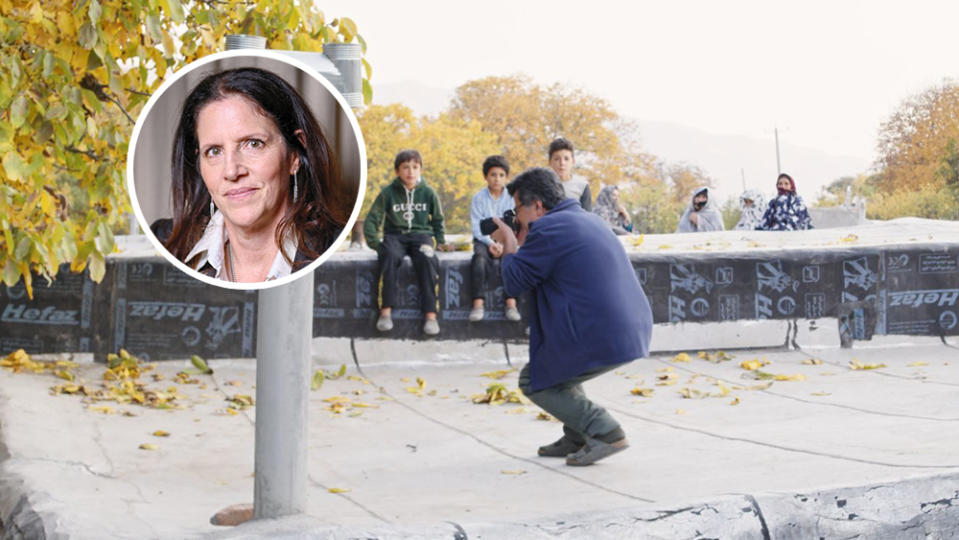
To watch “No Bears” is to experience a kind of cinematic vertigo: a renowned director goes to a rural village to remotely direct a fiction film about lovers escaping a country, who perhaps takes a photograph of young lovers in the village defying authority, and who perhaps himself is trying to escape.
Director Jafar Panahi is currently incarcerated in Iran for making films. In 2010, Panahi was making a film set during the previous wave of demonstrations against the government, and was placed under a 20-year ban from filmmaking and put under house arrest. His response was the brilliant and subversive “This Is Not a Film” (2011), a film about an idea for a film, shot for less than $5,000, smuggled out of the country, and premiered at the 2011 Cannes Film Festival. After that act of cinematic resistance and still banned from filmmaking, Panahi directed “Closed Curtain” (2013), “Taxi Tehran” (2015), “Three Faces” (2018), “Life” (part of the anthology “Year of the Everlasting Storm,” which I contributed to), and most recently his astonishing new film, “No Bears” (2022). I saw “No Bears” at the world premiere at the Venice Film Festival, two months after Panahi was arrested when he protested the detention of his fellow Iranian filmmakers, Mohammad Rasoulof and Mostafa Al-Ahmad. I could not stop crying.
The most haunting scene in the film finds Panahi, the director, at night on a remote road along the border of Iran and Turkey as his filmmaking colleague urges him to cross the border, and Panahi looks down and steps back.
In stepping back, Panahi stands in solidarity with the current protesters — many young women — defying their government’s authority.
Panahi is one of many filmmakers currently incarcerated for making cinema. The International Coalition for Filmmakers at Risk has more information about our colleagues around the world facing severe risk.
Filmmaker Laura Poitras won an Oscar for her 2014 documentary “Citizenfour,” and her latest doc feature, “All the Beauty and the Bloodshed,” won the Golen Lion at the Venice Film Festival in September.
Charlotte Wells’ ‘Aftersun’ by Claire Denis
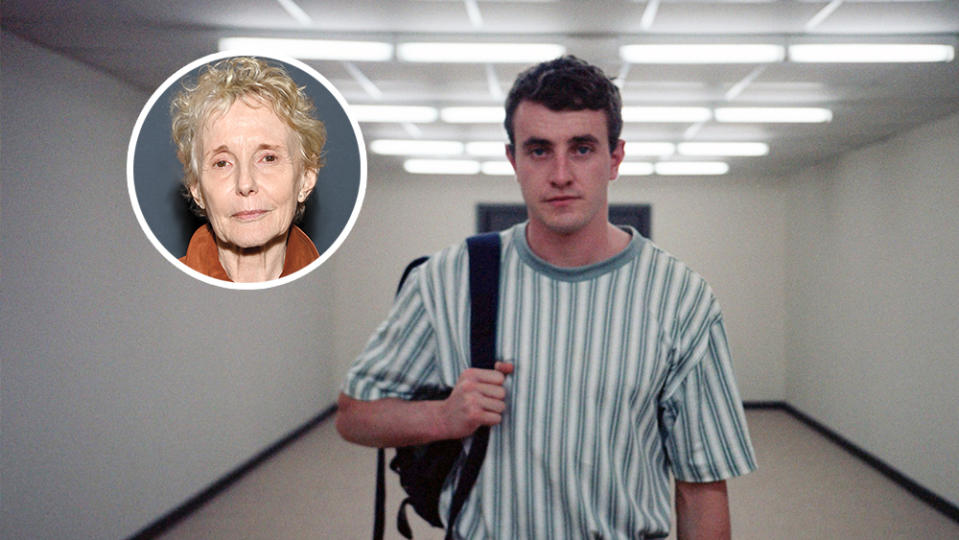
I discovered Charlotte Wells’ film “Aftersun” at the Morelia Film Festival in Mexico. The film was shown in a large, packed theater. From the first images, we are swept away by the director’s shifts in points of view, the glances exchanged between father and daughter. The directing style evokes the wavering, timorous sensations of the love they feel for each other, made intense because their time is running out: the time of their vacation, the time they share in the sun, by the sea, without her mother. Fragile time meted out to a fragile father.
Never before have I felt the power of a point of view that immerses us into gazes that dare to secretly spar in front of the lens of a small video camera. We are pulled in by the characters’ words too, which comprise a kind of game that slowly reveals the father to his almost adolescent daughter. Charlotte Wells leads us into a dark and frightening space, a moment of night when the father and the daughter split up to test their courage. This separation projects us into a future when the child will no longer be there to watch over — discreetly, intensely — her father, her guardian.
Frankie Corio radiates beauty and life. Charlotte Wells turns her into a detective who takes us down the secret trail that leads to her father. Paul Mescal is staggering in the role.
Filmmaker Claire Denis’ works includes “Chocolat,” “Beau Travail,” “Let the Sunshine In,” “High Life” and “Stars at Noon,” which premiered at the 2022 Cannes Film Festival.
Tobias Lindholm’s ‘The Good Nurse’ by Thomas Vinterberg
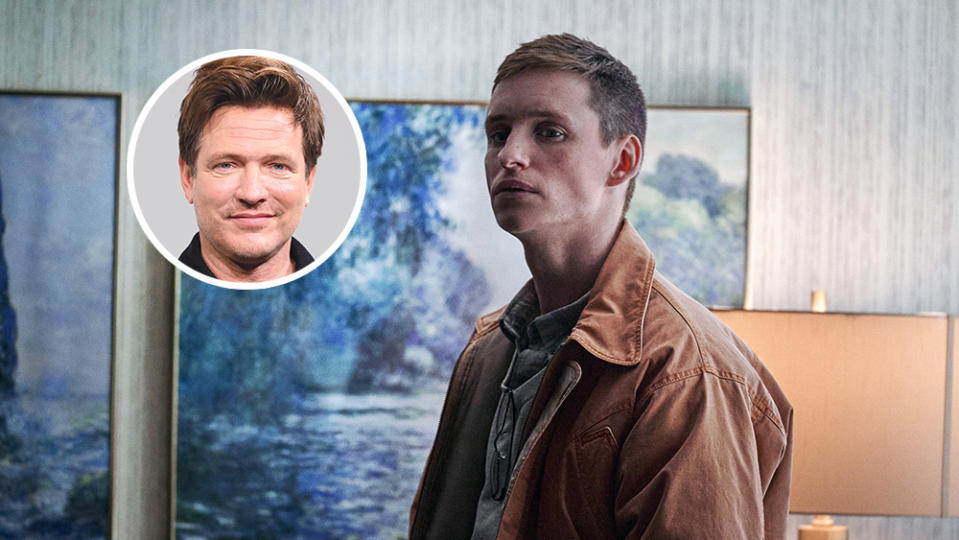
A composer once told me that the notes were there to serve the pauses. Where one note awaits the next and silence occurs is also where life and stories develop. The trio of Tobias Lindholm, Jessica Chastain and Eddie Redmayne have stunned me with their film “The Good Nurse.” Masterfully, they cultivate this very pause and the tension the unsaid brings forth amongst people when nothing distracts. Even the many murders are presented with such dignity that they do not interfere with what is happening between the two leads and how the improbable begins to unfold between them.
There’s no anxious attempt to entertain, no deviation of intent, just pure drama. It’s courageous. The story is told with authority and gravity. With this film, Lindholm leaps to a new level, having two of the world’s best actors giving him the wings to do so. Together they have created a spellbinding tale that had me catching my breath again and again.
I’ve been following Tobias since just after he left his youth as a graffiti painter behind — through our own collaborations, as well as through his creation of a string of pearls. “The Good Nurse” puts him on top.
It’s an accomplished, rigorous and gripping experience. The stringent structure, the vulnerability that develops between the two actors and Lindholm’s insistence on the unsolvable, ultimately becomes both thrilling and an attack on the American hospital system. A rebuke of the deep flaws in a system that perhaps only an outsider can see so clearly. Soberly and without pointing fingers, they have created a narrative that mirrors the inherent cynicism of the U.S. healthcare system. So inherent that even good people have adopted the completely amoral as a natural part of their lives.
However, cultures tend to close in on themselves, on their flaws, not only in the healthcare system but in systems everywhere. On the boards of banks, among Catholic priests, among the rulers of Russia … everywhere. And so “The Good Nurse” becomes both an intense, wrenching drama and a universal, grand telling of the collective lie.
Thomas Vinterberg directed Oscar-winning “Another Round,” “The Hunt” and “The Celebration.”
James Gray’s ‘Armageddon Time’ by Alexander Payne
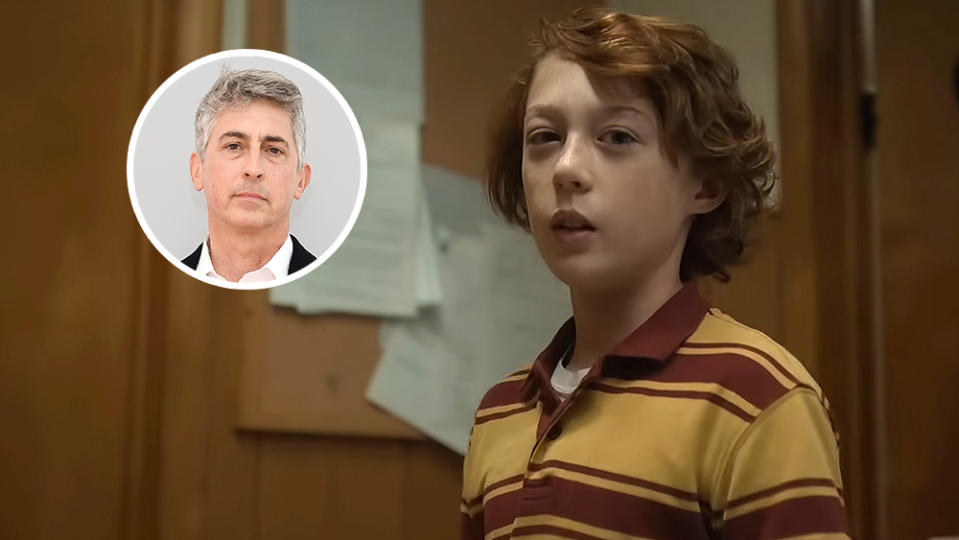
Gabriel García Márquez used to say that “creation is memory.” James Gray’s movies, particularly the early ones, succeed in no small part because they seem drenched in elements of his memory — memory of his youth in New York, of the Russian Jewish ethos of his family and community, memory even of the 1970s films that inspire him. Now he has excavated directly from memory a turning point of his own experience as a boy, and the resulting film — poignant, funny, horrifying, emotional but never sentimental, authentic, astonishing — takes its place beside the finest and most honest of the personal coming-of-age films. James Gray has made his “I Vitelloni.”
As in all his movies, the filmmaking craft in “Armageddon Time” — production design, costume, cinematography — fires on all cylinders to conjure up an utterly convincing, utterly lived-in world of his youth.
But it’s his screenplay and casting that most impress. The episodes, events, and moments of choice are strung together in a seemingly impressionistic fashion yet, as in all great screenplays, evince rigorous discipline.
The characters, in particular James’s alter ego, Paul, and his parents, do true things: wrong things and right things, one thing and the opposite thing. The actors embody the pathos, humor and paradoxes of their characters to such an extent that I came away feeling that I knew them in real life.
Another quote leaping to mind is a more ubiquitous one: the more specific, the more universal. James’ film is about himself and his family, but I saw myself and my own struggles with myself and with family. I heard echoes of myself in the choices I made as a kid and continue to make as I stumble my way through life. But no matter how maladroit the actions of his characters, James Gray paints them with compassion and understanding. Understanding — what else is there? We’re not bad people. We’re just doing it all for the first time.
Alexander Payne is the Oscar-winning writer-director of such films as “Sideways” and “Nebraska.”
Ruben Östlund’s ‘Triangle of Sadness’ by Edgar Wright

Huge swells of hysteria erupted. The walls quaked with shock and awe. This isn’t a description of the already notorious stormy centrepiece of Ruben Östlund’s “Triangle of Sadness,” but a description of the roiling crowd I watched the film with. I roared along at a riotous packed festival screening with 2,700 other audience members. It was my most memorable screening of the year and a necessary reminder that seeing a film on the big screen is an unmatched experience.
The captain leading us headlong into this wild surf is Sweden’s master provocateur Ruben Östlund, who has risen in the last decade to become one of the most exciting writer-directors around. Having enjoyed “Force Majeure” and “The Square,” my hopes were high for his new (consecutive!) Palme D’Or winner. Thankfully, my expectations weren’t just met but extravagantly surpassed. Oftentimes, the award cycle can feel like a doleful slog through weighty, worthy subject matter; a bit like eating your cinematic vegetables. Then along comes Ruben, with a film that has plenty to say about the obscene gap in the living wage but is also smart and witty entertainment, brilliantly structured, perfectly performed and masterfully directed to create a purely theatrical experience from start to end. Please note: Great cinema can be fun too. Taking inspiration from masters like Buñuel and Godard (I got a welcome scent of Lindsay Anderson too), this class-warfare satire explodes onto the screen. I was unaware of the entire third act going in and it completely lifted the roof off the cinema. Dolly De Leon commanded the movie in its final stretches in a turn of events that had my audience cheering. I can’t wait to see where Östlund steers us next. But, for now, I would like to stand and applaud this mischievous hand grenade of a film, primed to detonate the entire season.
Edgar Wright directed and co-wrote such hits as “Shawn of the Dead,” “Hot Fuzz,” “The World’s End,” “Baby Driver” and “Last Night in Soho.”
Daniel Kwan and Daniel Scheinert’s ‘Everything Everywhere All at Once’ by Cathy Yan
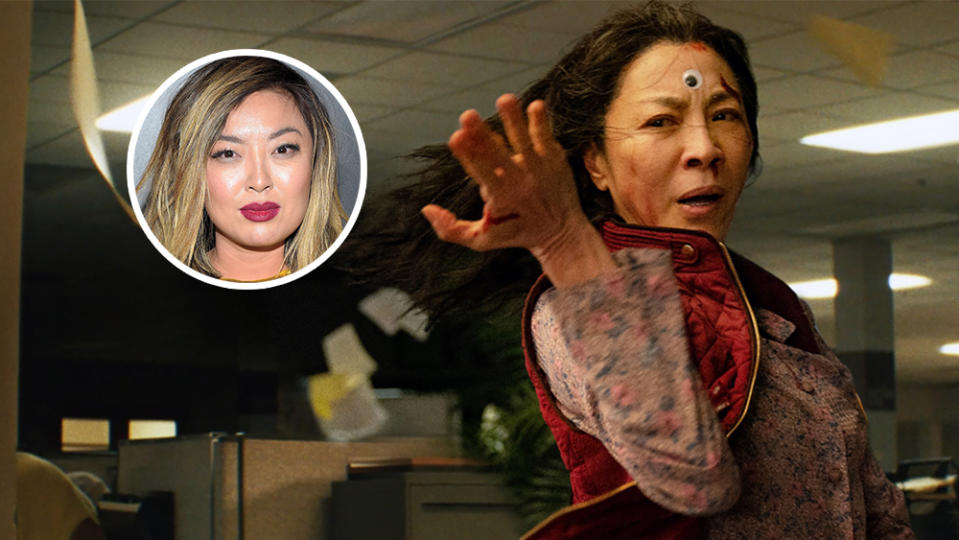
“Everything Everywhere All at Once” breaks all the rules. Yet the Daniels are so in command of their craft that they don’t just pull it off, they’ve expanded my idea of what a film can and should be. It is CINEMA!! in all caps and exclamation points.
The Daniels bottled the humor and pace of the internet; mixed it with kung fu films, “Ratatouille” and Wong Kar Wai; added a very scary everything bagel; topped it off with some sausage fingers; then served it to us in the once familiar form of a feature film. I completely surrendered to their wild vision through multiple universes, genres and volatile emotions. How did they do that? What are they on?
But what strikes me as equally daring is its heart. In our universe of tested-to-death blockbusters and cooly distant arthouse fare, their film gives us a glimpse to a parallel one: one where a film still has the power to draw busy millennials into theaters, to make even the most stone-hearted of us ugly cry, to start difficult conversations around a dinner table, and to change the face of the American family.
I could go on about the film’s exquisite craft, the incredible range of the performances, the masterful editing and the insane costumes of one Jobu Tupaki. But the ultimate movie magic of EEAAO is that it shows us what’s possible, in this universe and beyond.
Cathy Yan has directed film “Dead Pigs,” an Emmy-nominated episode of “Succession” and is set to direct “The Freshening.”
Alice Diop’s ‘Saint Omer’ by Audrey Diwan
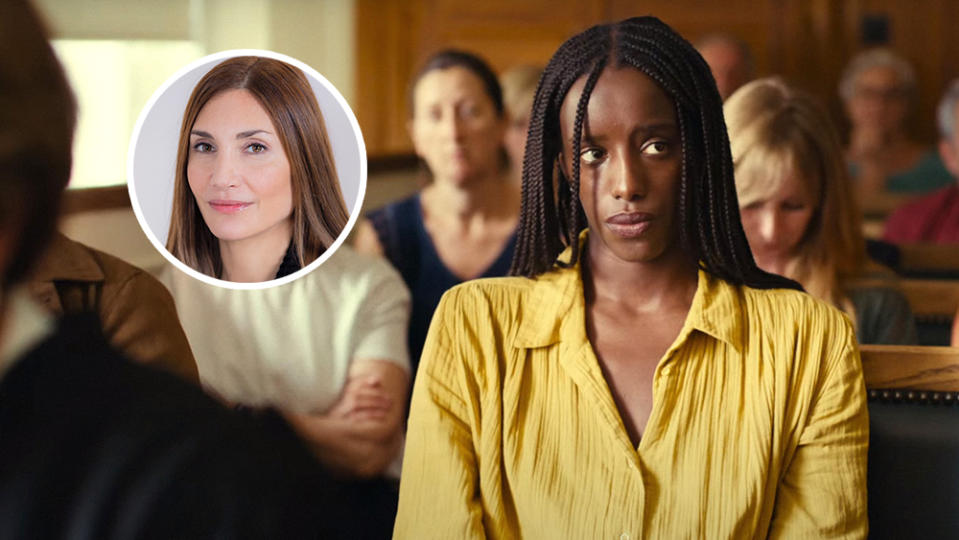
A great film is measured by the echo that resonates in the room at the end of the screening. I discovered “Saint Omer” at the Venice Film Festival where I was part of the jury. I will never forget the special effect the film had on its audience. At the end of the credits, I remember a buzz, you could feel it animated by a thousand questions, the rising murmur was palpable, alive. The work gives rise to debate, it invites discussion, collective thinking. Alice Diop gracefully and radically questions our ability to judge. Her film is based on a news item. Even before the start of the trial, everything accuses the main character, Laurence Coly — wonderfully interpreted by the powerful Guslagie Malanda — this Black woman, educated, accused of infanticide, designated in advance as guilty. Our eye is not neutral, our gaze is the fruit of our history, of our education, it also carries heavy, silently anchored prejudices. Are we able to question this look, to make it evolve? Alice Diop asks the question bluntly. The film takes place for the most part in the court, as if the director told us not to evade the situation, as if she invited us to live it without cheating. This assumed device carries the subject and plays with our contradictions, our discomforts. That evening, we all walked out of the room as if we were leaving the court, imbued with the idea that justice only has meaning if thought is free. Alice Diop’s voice has never left me since. No doubt: “Saint Omer” is a great film.
Audrey Diwan’s “Happening’” won the Golden Lion at the 2021 Venice Film Festival. She’ll make her English-language directorial debut with “Emmanuelle,” starring Léa Seydoux.
Maria Schrader’s ‘She Said’ by Lena Dunham

Maria Schrader has established herself as a brilliantly subtle chronicler of modern female sexual appetites. In “Unorthodox,” she was examining a Hasidic woman’s shaky but brave bloom as she moves away from inherited structures of imposed subservience. Her camera hovered at eye level with her heroine, giving us unparalleled access to her inner life.
In “I’m Your Man,” a workaholic whose love life has left her bitter and exhausted tries an android partner on for size. We watch them waltz and f-ck but yet again the story is in her protagonist’s eyes, all the loss and fear that comes along with new (albeit manufactured) love.
Schrader gets into the spaces between words and actions, where past trauma and current social structures mingle to create the template for an inner life. Which is why she was the perfect director to take on the horrors of Harvey Weinstein through the lens of the women who reported the bombshell New York Times story that marked the first chink in his armor.
Like all Schrader’s heroines, Megan Twohey and Jodi Kantor live in the spaces between actions and words. As reporters, they ask questions but they also have to wait with empathy and focus for their answers. Schrader solves the problem of how to dramatize the journalistic process by choosing to comment on it. What does it mean when, in order to expose wrongdoing, we must also ask hard questions of already traumatized people, exposing them to the wrath of the public? Schrader stays in the eyes of the journalists and of their subjects to render all that complexity. She punctuates the narrative with flashbacks, not to the assaults themselves but to the quiet and isolated aftermath, when the women affected finally get a moment alone.
Schrader’s lack of sensationalism allows “She Said” to become more than an accounting of crimes. It asks how these crimes take root in the collective conscience, in our bodies, in our eyes. In Schrader’s world, it’s all in the eyes.
Emmy-nominated director-writer-actor-producer Lena Dunham’s latest film is “Catherine Called Birdy.”
Jordan Peele’s ‘Nope’ by Andrés Muschietti
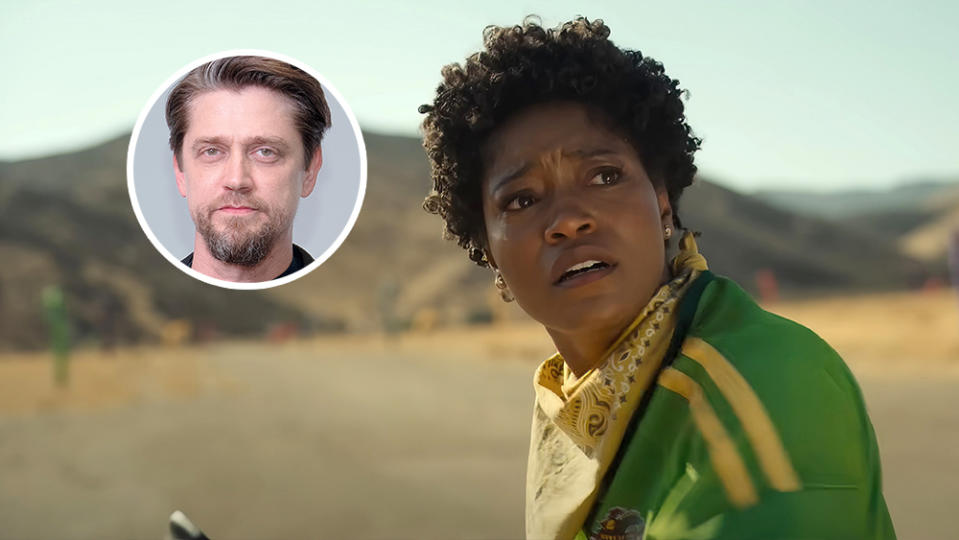
It’s quite unusual that a filmmaker uses the themes of his movie to create an experiential game with the audience. That is what Jordan Peele does so well in “Nope.” The “addiction to spectacle” is not only a subtextual idea in the story but more importantly a very intentional exercise of tension that he puts the spectators through.
When you witness the opening scene where we see Gordy the chimpanzee covered in blood and wandering the aftermath of a massacre; when we see an “alien” in the shadows, staring at us from the other end of a corridor for what it seems like hours; when we look up at the night skies trying to figure out what the hell is hovering behind the clouds, we CAN’T TAKE OUR EYES OFF THE SCREEN. It’s through these nerve-racking mini spectacles that you will viscerally experience the theme of the movie in the flesh as opposed to (or, as well as) rationally/emotionally understand it once the movie is watched.
Two other themes in Jordan’s movie are the senseless exploitation of nature and childhood trauma. It took me a while to understand why, in the opening scene, Mary Jo’s bloodied shoe is standing upright in a physically impossible way — one of the film’s most powerful and surrealistic images. Watching it for a second time, I realized that the shoe is standing upright because that’s the way its displayed in a glass case in Jupe’s “Gordy’s Museum” decades later. It’s safe to assume then that the film’s opening scene is not an objective telling or a vivid recollection of what happened that infamous day but most likely something filtered through the lens of a child who will cope with trauma for the rest of his life.
If I’m not wrong about this theory, hats off to Jordan for the additional layer of magic in storytelling. I would not be surprised because Jordan is one of those filmmakers that stimulates the spectators’ minds by playfully asking them to put the pieces together. And this is one exciting puzzle.
Andrés Muschietti is the director of the upcoming film “The Flash,” as well as films such as “It,” “It 2” and “Mama.”
Noah Baumbach’s ‘White Noise’ by Wes Anderson
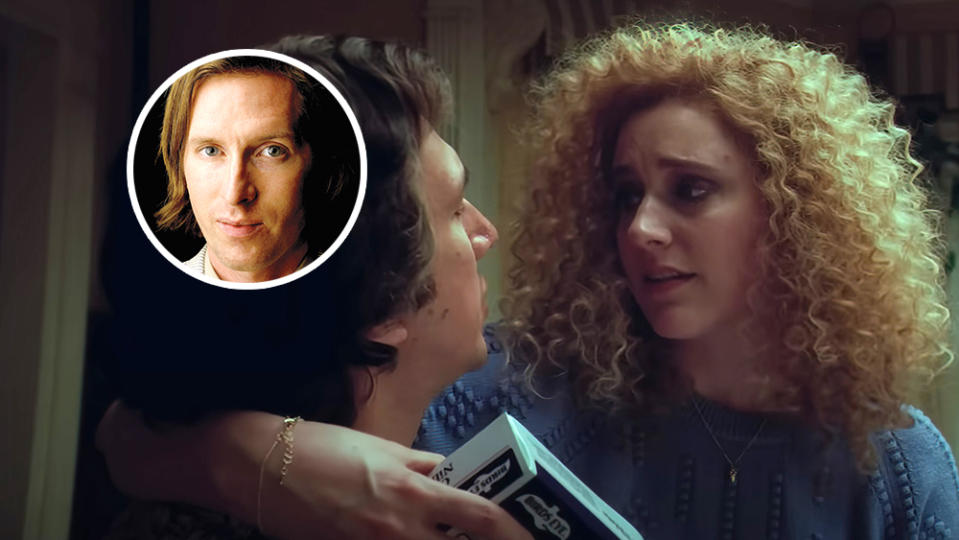
Noah (in my experience/observation) writes directly from his own life and finds the funniest, saddest, most memorable, most moving things to transform and reinvent and turn into scenes and movies. Not this time: his inspiration is a book! But, somehow, while it’s Don DeLillo — it’s still him. This is perhaps the most literary (and language-oriented) gigantic semi-science fiction blockbuster-scale movie ever made. College professors lecture. Academics debate. Grocery shoppers dance in the aisles. A giant toxic cloud is an existential threat; but first and foremost, it’s a metaphor.
This movie is dazzling and mysterious and poetic and wildly entertaining. It’s a completely new concoction from one of our most original voices who has refined and developed his talents in ways we can only stand back and admire (and enjoy). As I recall, François Truffaut explained to his actress: “Every film is a brick in the wall”; and she (Isabelle Adjani) answered in her stunning youth: “No. Every film is the wall.” This wall is unlike any other we have ever seen — and every brick was built to last.
Oscar-nominated filmmaker Wes Anderson’s features include “The French Dispatch,” “Isle of Dogs,” “The Grand Budapest Hotel” and “The Royal Tenenbaums.”
Todd Field’s ‘Tár by Tony Gilroy
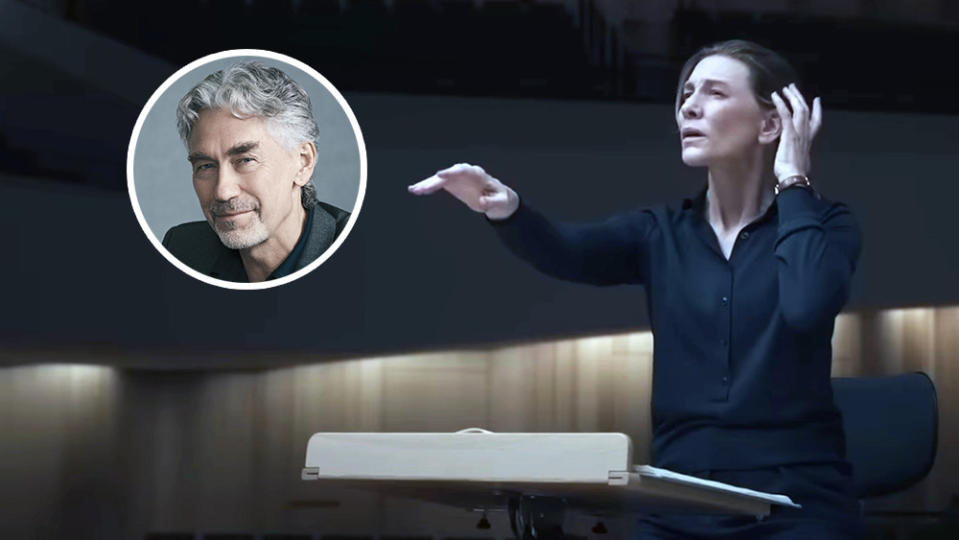
I want you to know how much I loved this film.
I want to tell you why in the most concise, controlled, compressed manner possible. But when I’m done, I want you feel that I’ve barely scratched the veneer, because that’s exactly how I felt seeing “Tár.”
I want you to know how blown away I am by Todd’s craftmanship and rigor; the casting, the performances, the specificity of the world-building, the exciting, unselfconscious camerawork, the color-temperatures, the mix, the tempo … I want you to know, from a purely technical perspective, how impressed I am with the way he’s made and delivered this unusual movie. But those are all tangible filmmaking components; a bit more than veneer, perhaps, but they’re all, ultimately, variables of taste, economy and how much obsession can be wrestled to the screen.
What makes this film extraordinary to me — the thing I want to carry forward and remember — is the chaos inside all that. Because it’s that friction that makes this film so powerful for me. How do you marry precision and enigma? How do you make something so firmly controlled and have it spilling over with the unresolved anarchy of real human behavior? How do you pull off disorientation and vertigo inside of such a confident machine?
And then, the coup de grâce — Cate Blanchett. How brilliant and brave to place, at the center, a character whose every scene builds toward that same idea, that same dissonance.
Hard and perfect on the outside. Mayhem brewing within. Masterwork.
Tony Gilroy wrote and directed “Michael Clayton” and is the creator of the Disney+ show “Andor”.
Baz Luhrmann’s ‘Elvis’ by Guillermo del Toro
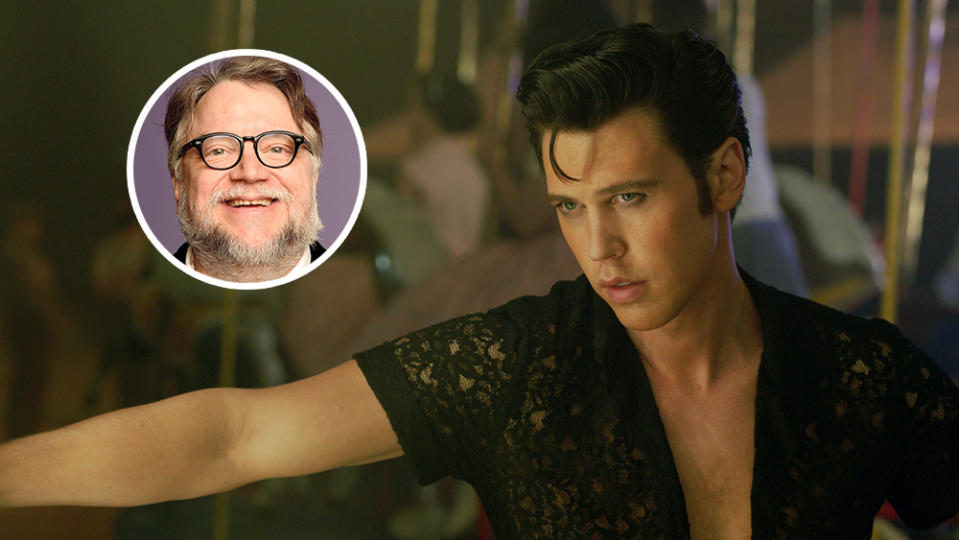
There is only one Baz Luhrmann. That’s a fact.
I was lucky enough to be in Cannes when Baz premiered his breathtaking “Elvis,” and I was proud to be part of the audience’s 12-minute standing ovation. It was like a concert — it was experiential, peppered with details and perfectly observed mannerisms and hidden clues. Austin Butler and Baz showcase Elvis’ world shaking, transformative talent, his joy, his soul, his sadness — actor and director working in tandem to re-embrace and re-energize the power and danger that Elvis possessed.
There is incredible control when composing a Baroque piece of cinema like “Elvis” — incredible control of the tools of audiovisual storytelling: staging, lensing, moving the camera, controlling the cutting rhythms, and using sound design and music with virtuoso precision. And sustaining that pitch when is needed and being able to ease on the gas or ramp up when it is not.
Baz’s work with actors has long been legendary, with career-defining performances from Leonardo DiCaprio to Nicole Kidman and Ewan McGregor. Here, Baz’s work with Austin has created the definitive portrait of Elvis Presley and launched a superstar.
But the secret element in a Baz film is Baz himself: The undomesticated autonomy he has, the unwavering, indefatigable faith and relentless work ethic that has made him a maestro, and in fact, the single purveyor of his style of films. The impossible paradox of energy and total control goes hand-in-hand with another one: the fact that by making the most personal body of work, he has reached the universal truth and the soul of filmgoers everywhere. Against all odds he believed in, and delivered, once more, a film that had audiences returning to theatres after the pandemic.
Such is the power and purity of Baz — our only Baz and his belief in Truth, Beauty, Freedom — and, above all else: Love. Love of Cinema, Love of Emotion and Love of Love.
Oscar-winning helmer Guillermo del Toro’s latest film is “Guillermo del Toro’s Pinocchio.”
Ron Howard’s ‘Thirteen Lives’ by John Lee Hancock
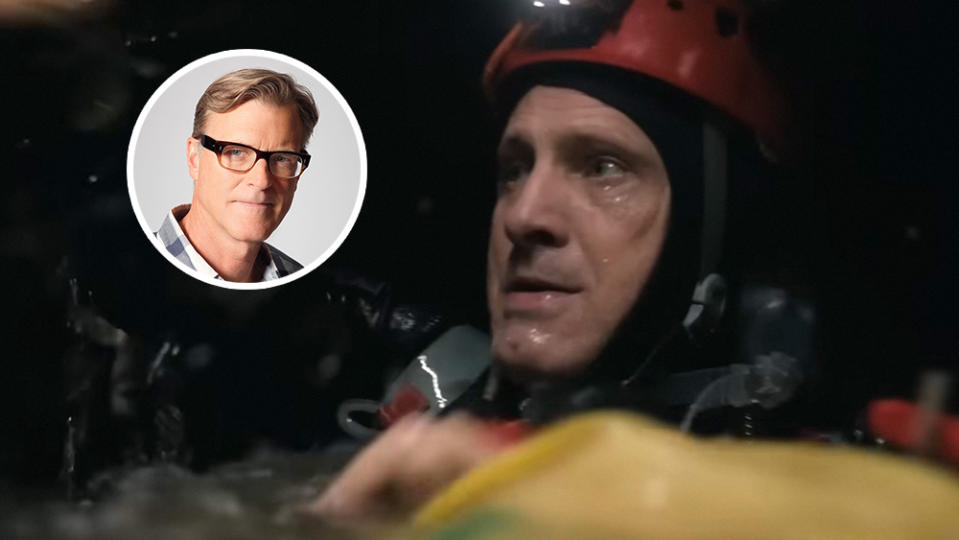
When you look at the long list of films Ron Howard has directed, a couple of things come to mind. One, damn, that is a lot of movies, and two, that is a lot of really great movies. When I first read that Ron was directing “Thirteen Lives,” I wasn’t sure the story was a movie, or at least it was beyond me to understand it as one. We’d all heard the terrifying saga of the Thai soccer team and watched in real time as the rescue efforts went on for more than two weeks. So, it’s a documentary, right? And a good one. But is it a narrative film?
I’m happy that my instincts about the material were proven wrong. I should have known better than to doubt Ron’s taste and flawless execution, no matter the subject matter, genre or degree of difficulty. I’ve had the pleasure of watching Ron direct in person, and the gentle care he gives the story, and everyone making it, is really a pretty profound thing to experience. He’s in complete control while putting his arms, sometimes literally, around every aspect of the storytelling. His “Thirteen Lives’” star-studded cast, including Viggo Mortensen, Colin Farrell and Joel Edgerton, could have easily overwhelmed the story, but under Ron’s guidance (and their immense talent) all three come across not as bigger-than-life movie stars, but instead as real people doing their best in an impossible situation. They seem like men we know. Heroes, yes, but in a very real and understated way. In fact, the whole film feels real — like we’re actually there, not watching through the lens of a camera, and that is a very tough thing to pull off.
Needless to say, I’ll never doubt Ron Howard again.
John Lee Hancock directed “Mr. Harrigan’s Phone,” “The Rookie,” “The Founder,” “Saving Mr. Banks,” and wrote and directed “The Blind Side.”
Elegance Bratton’s ‘The Inspection’ by Lee Daniels
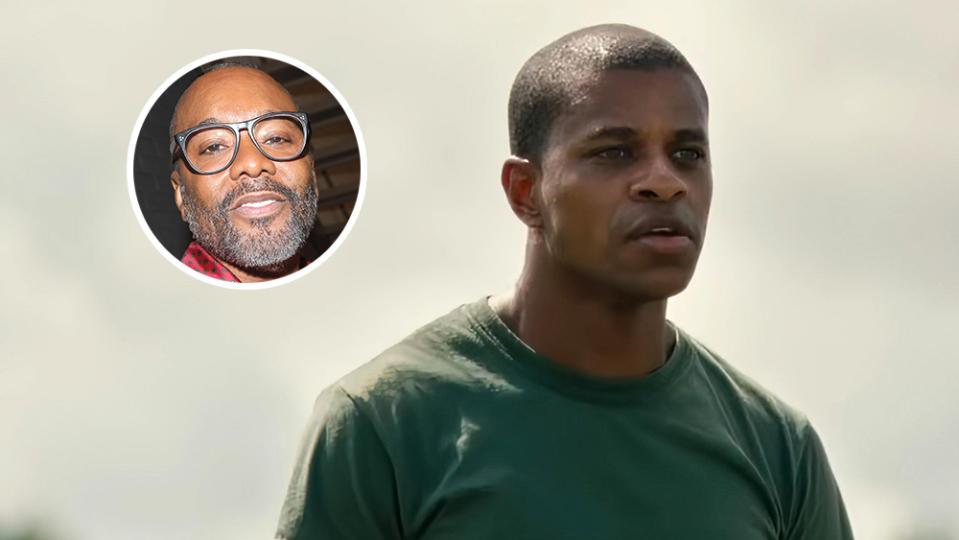
With “The Inspection,” the aptly named Elegance Bratton directs a masterful coming-of-age story that is at once both so specifically Black and queer while also incredibly universal. The Black queer experience of “The Inspection” is rooted in an experience all Black queer individuals must endure and overcome if we are ever to find true serenity — being Black in a country that doesn’t want us, and being gay in a family that, at best, struggles, and at worst, refuses, to accept us.
A less, dare I say it, elegant director might tell this story in a more expected, a more melancholy way. Poor me. Look how sad and hard my life was. I’ve had to overcome this terrible mother. I was homeless. Then, I was brutalized in the Marines because I’m gay. But Mr. Bratton, in his feature film debut, avoids these tropes that readily plague Black and queer storytelling, opting instead to explore our experiences with nuisance, compassion and empathy.
Every frame, and every character, pulsates with the painful truth that stories such as Mr. Bratton’s are forged from a lived experience that should not have to be lived. No child should fear rejection from their mother because of who they love. Just as no mother should be made to believe that her child is less worthy of her love because of who they chose to love.
It is far easier to judge the character inspired by Bratton’s own mother — played so daringly by the almost unrecognizable, but never been better, Gabrielle Union. But it is far more compelling to try to understand her. And that is what “The Inspection” challenges its viewers to do — to understand.
Director-writer-producer Lee Daniels is a two-time Oscar nominees for “Precious” and is behind such hits as “Empire,” “The Butler” and “The United States vs. Billie Holiday.”
Scott Cooper’s ‘The Pale Blue Eye’ by Ramin Bahrani
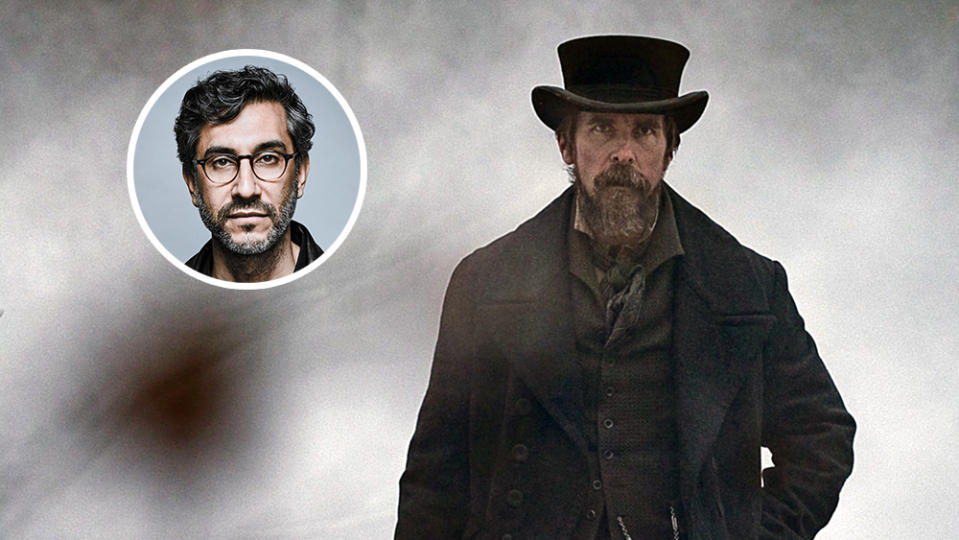
With “The Pale Blue Eye,” Scott Cooper has pulled off a tremendous balancing act — it is a whodunit, a father-son love story and an Edgar Allan Poe origin story all in one film. Cooper masterfully weaves these strands together while taking audiences on a journey full of unexpected twists. The surprising denouement is a powerful emotional punch and a complex moral catharsis. I loved it.
Cooper is known for his casting and his work with actors, and he has gathered an impressive ensemble that any director would envy. Leading the troupe is the brilliant Christian Bale as Detective Landor. He is by turns a stunning intellect full of wit and strength, and a brooding, vulnerable obsessive. The supporting lead, Harry Melling, brings Edgar Allan Poe to life with surprising verve and idiosyncratic humor. He’s also sharp, arrogant and cocky, holding his own against Landor (and also against Bale — no small feat for any actor!). They are electric together and form the beating heart of Cooper’s brilliant new tapestry.
Nobody is who they seem at first glance. This is a film you need to see at least twice to understand what Cooper and Bale have orchestrated together. The resplendent nuances and contradictions of Bale’s performance are only fully appreciated when you know the film’s ending. And Cooper, as writer and director, has calibrated every line of dialogue, every shot, every cut, perfectly. Cooper has a power to reveal the inner lives of his actors and also of his locations. The frigid cold we see and feel in the film (Scott told me it was often well below zero!) and the rigid rules and formalism of West Point, where the film is set, constrain and contain the psyche of his characters — ideas Cooper grapples with in his previous films. And a theme may be emerging in Cooper’s recent work: broken Americans souls wrestling with the ethics of revenge as they search for peace. “The Pale Blue Eye” is a brilliant new edition to his oeuvre.
Oscar-nominated Ramin Bahrani wrote and directed “The White Tiger,” and is an exec producer on “Joyland.”
Lukas Dhont’s ‘Close’ by Mary Harron
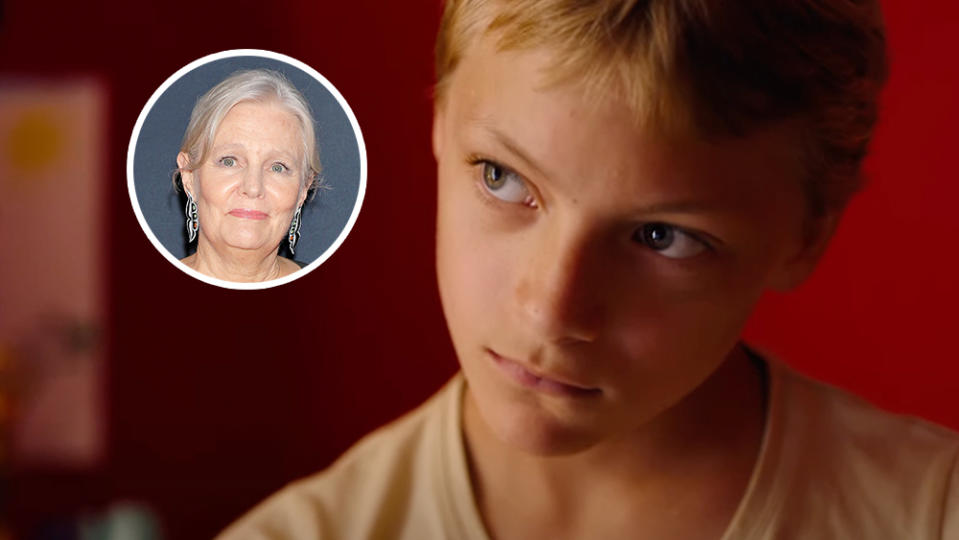
With great beauty and delicacy, “Close” captures that moment when you leave the bubble of childhood for the treacherous terrain of adolescence. Director Lukas Dhont first draws us into the safe, private world of two 13-year-old boys, Leo and Remi, who have an intense and all-absorbing friendship, filled with games and make-believe and races through flower-filled fields. This world is a kind of Eden, short-lived as childhood idylls inevitably turn out to be.
Dhont discovered Eden Dambrine, who plays Leo, when he sat near a bunch of schoolboys on a train and watched him hold his friends spellbound with stories. Dambrine has a vivid presence that carries the film, along with Gustav de Waele’s performance as Remy — more internal, but also compelling. Early on, we see their effortless, unselfconscious physical affection: sleeping in the same bed, arms around each other, so comfortable with each other’s families, they seem like brothers.
Soon they will have their first day at a new school, and gradually, excruciatingly, Dhont shows us the outside pressures that chip away at this bond.
The attachment between the boys is pre-sexual, a kind of love rarely portrayed on film.
There is nothing cliched or heavy-handed in Dhont’s approach. Leo doesn’t want to hurt Remi, but he longs to explore the wider world of boy culture: the hockey team, the banter. Remy doesn’t belong in that world and he suffers. But there are no villains, and the bullies are clearly motivated by fear and shame.
I defy anyone to watch “Close” and not have their hearts pierced by their own memories of adolescence. Who did not hide their own nature in order to fit in with the group? Who did not betray a friend? The truth of this story, and the power of the filmmaking, will be just as sharp in 20, 30 or 50 years as it is today.
Mary Harron directed “I Shot Andy Warhol” and “American Psycho” among others, as well as series “The Expecting,” which she also exec produced.
Luca Guadagnino’s ‘Bones and All’ by Karyn Kusama

There’s a scene early in Luca Guadagnino’s “Bones and All” in which two drifters, Maren and Lee (beautifully played by Taylor Russell and Timothée Chalamet) enter the home of a man that Lee has recently killed. At this point we know they are both “eaters” — a deceptively simple term for cannibals — and there is something paradoxically tender in these initial scenes between them, as if young love is almost inevitable now that they have witnessed the other for who they really are without fear or judgment. Lee puts on a song, Kiss’ “Lick It Up,” mentioning that the band is playing without their trademark make-up: the masks, as it were, have been abandoned, and so too for this singular film. As he dances around the room and sings along to a cock rock classic, we’re offered a jolt of pure pleasure. Humorous and metaphorically rich, it’s one of many great moments in a movie that dares to be funny, tragic, and deeply uncompromising.
Marked by startling supporting performances from, among others, Michael Stuhlbarg, Mark Rylance and Jessica Harper, as well as an ambitious screenplay from Guadagnino’s frequent collaborator David Kajganich, this might be Guadagnino’s most tonally intricate feature yet, within an oevre already defined by his exquisite sensitivity to the dramas and traumas of cultural outsiders. “Bones and All” is a thrilling genre mash-up — an outlaw love story set within Reagan’s America, and a legitimately terrifying story of moral and physical transgression. Maren and Lee’s trek across the Midwest — in which their victims are nearly as invisible as they are — takes on a peculiarly American quality, as their dreams of social mobility evaporate in the face of untenable appetites. Calling to mind the same fraught emotional dynamics of addiction and mental illness, their sickness is one they didn’t ask for and can’t cure — and like many who suffer with these ailments, society offers them little hope to belong. Guadagnino demands that we summon our compassion for the shunned among us, as “Bones and All” is, above all else, a film of deeply spiritual concerns.
Karyn Kusama is a director whose films include “Jennifer’s Body,” “The Invitation” and “Destroyer.” She recently directed the pilot episode of Showtime’s “Yellowjackets.”
Best of Variety

